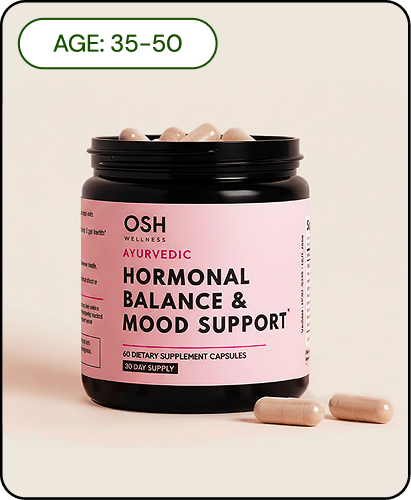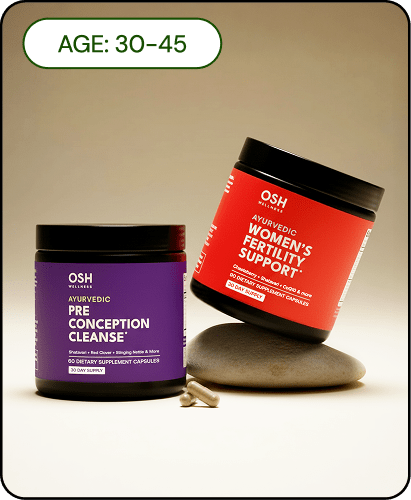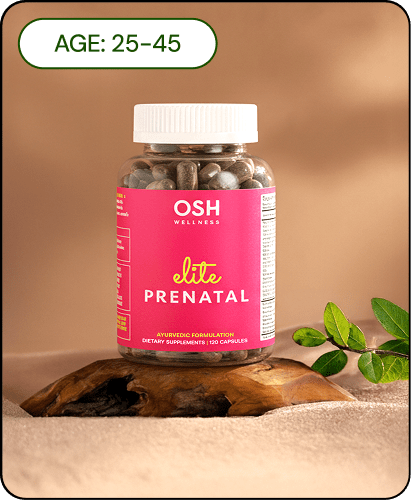Table of contents
Hormonal imbalances are increasingly common, particularly among women in their reproductive years. Conditions such as Polycystic Ovary Syndrome (PCOS) and Premenstrual Syndrome (PMS) highlight a growing need for effective and sustainable approaches to women’s health. Ayurveda, an ancient holistic system of medicine, offers targeted cleansing, dietary changes, and lifestyle transformations to bring the body back into balance. This article explores Ayurvedic remedies for reclaiming hormonal health naturally.
Understanding Hormonal Imbalances in Women

Hormonal imbalances are a major health concern, affecting nearly 80% of women during their lifetimes. PCOS alone impacts 6–13% of women of reproductive age, yet up to 70% of cases go undiagnosed. This condition presents through symptoms like irregular menstrual cycles, increased androgen levels leading to hirsutism, and metabolic complications that often begin in adolescence and shift over time [1].
External symptoms may include unexplained weight gain, fatigue, acne, and disrupted sleep. Psychological indicators such as mood swings, anxiety, and brain fog are also prevalent, significantly impairing daily functioning and mental well-being [2].
Modern stressors poor diet, disrupted sleep, high stress, and environmental toxins, contribute significantly to hormonal inconsistencies. Ayurveda offers a personalized approach rooted in doshas (body constitutions), taking into account an individual's body type, mental state, and life stage to bring harmony using natural methods like diet, yoga, herbs, and detoxification [3].
The Ayurvedic Perspective on Women's Health

At the heart of Ayurveda lies the belief in balancing doshas (Vata, Pitta, and Kapha), agni (digestive fire), and srotas (body channels). Understanding these elements is key to solving long-term hormonal imbalance and resilience across the female lifecycle.
Kapha dominates in childhood and supports growth and maturation.
Pitta governs reproductive years and regulates hormones and metabolism.
Vata influences the perimenopausal and menopausal stages, requiring extra grounding efforts [4].
Strong digestion (agni) transforms food into vital resources for hormonal function. Weak agni creates toxins (ama), leading to cycle irregularities or conditions like Premenstrual Dysphoric Disorder (PMDD) [5]. Additionally, blockages in female reproductive channels (artava vaha srotas) can result in menstrual or fertility challenges [6].
Ayurvedic care offers tailored treatment using herbs, yoga, pranayama, and lifestyle changes to strengthen the mind-body connection. This integrated approach facilitates deep healing and renewal [7].
Panchakarma: Detoxification and Rebalancing

Panchakarma is Ayurveda's cornerstone detox therapy, aimed at clearing toxins (ama) and restoring balance among the doshas. It consists of five main treatments:
Vamana (therapeutic vomiting) addresses excess Kapha and respiratory/metabolic issues [8].
Virechana (purgation therapy) purifies the liver and reduces Pitta-related disorders like skin irritations and digestive issues [9].
Basti (medicated enema) targets Vata imbalances, improving gut health and mental clarity [10].
Nasya (nasal therapy) supports brain, sinus, and neurological health.
Rakta Mokshana (bloodletting) removes toxins from the circulatory system.
These therapies collectively rejuvenate hormonal function by enhancing metabolic efficiency and clearing srotas. Case studies demonstrate substantial relief from hormonal imbalance, PCOS and PMS symptoms following comprehensive Panchakarma regimens [11].
Herbal Allies for Hormonal Regulation

Ayurveda leverages the power of medicinal herbs to support hormonal health. Notable herbs effective in the context of PCOS and PMS include:
Shatavari enhances ovarian function by improving folliculogenesis and regulating menstrual cycles [12].
Ashwagandha reduces inflammation, balances adrenal function, and supports fertility [13].
Fenugreek improves insulin sensitivity and modulates hormones linked to metabolic syndrome and PCOS [14].
Together, these herbs create a powerful synergy for restoring reproductive harmony. When used under professional guidance, they can form a safe, sustainable alternative to synthetic treatments for hormonal imbalance [15].
Nourishing Your Body: Ayurvedic Dietary Strategies

Adopting an Ayurvedic, Kapha-balancing diet helps combat the stagnation and heaviness often associated with hormonal imbalance.
Recommended foods include:
Fresh vegetables and leafy greens like spinach, broccoli, and carrots.
Whole grains such as quinoa, millet, and barley for sustained energy [16].
Healthy fats like flaxseeds or ghee support hormone synthesis.
An ideal day might begin with warm lemon water, followed by millet porridge and lightly sautéed greens. Midday meals should be largest, such as steamed vegetables with dal while dinners should be light, featuring broth-based soups with digestive spices like ginger and turmeric [17].
Avoiding heavy, oily, or sugary foods is critical, as they aggravate Kapha and hinder digestion. Regular meal timings and mindful eating align with Ayurveda’s emphasis on digestive wellness and hormonal integrity [18].
Integrating Lifestyle Changes for Optimal Health

Lasting hormonal harmony depends not just on food and herbs but also on adopting a consistent, nurturing lifestyle. Incorporating a daily dinacharya that includes self-care habits promotes faster and deeper healing.
Daily routines regulate biological rhythms for optimized hormonal release.
Yoga and meditation reduce cortisol and enhance mental resilience. A NIH study found regular yoga reduced PMS and PCOS symptoms by lowering stress markers [19].
Prioritizing sleep and emotional well-being reinforces endocrine health. Quality rest and interpersonal support can directly influence hormonal cycles [20].
Women are encouraged to begin with small, sustainable shifts, consistent bed/wake times, 15 minutes of morning stretching, or mindful meals. These small acts build toward comprehensive balance over time [21].
Relevant Products
At Osh Wellness, we offer tailored hormonal balance support for women through different stages of life.
- For women 20-35 or before trying to conceive: Cycle Care is a blend of 7 botanicals that help address PMS symptoms and irregular periods.
- For women planning to conceive: Preconception Cleanse offers a blend of detoxifying herbs that nurture fertility, menstrual regularity, and hormonal cleansing.
- For women postpartum or 40+: Hormone & Mood Support helps regulate hormones, including cortisol, reduce mood fluctuations, and promote restful sleep.
Conclusions

Ayurveda presents a holistic, evidence-supported approach to managing hormonal imbalances through detoxification, herbs, dietary tailoring, and mindful living. Especially for conditions like PCOS and PMS, this integrative method empowers women to take charge of their health with time-honored and natural solutions.
By embracing Ayurveda’s wisdom alongside contemporary health practices, women can reclaim their vitality, balance, and inner harmony.
Sources
1: WHO - Polycystic Ovary Syndrome
2: Northwell - 11 Unexpected Signs of Hormonal Imbalance
3: Rupa Health - Balancing Hormones in Younger Women: A Comprehensive Guide to Hormonal Health
4: One World Ayurveda - Doshas and Hormonal Health
5: Healthline - Vata, Pitta, and Kapha Doshas Explained
6: AF Women's Health - Women's Health Library
7: One World Ayurveda - Ayurveda and Women's Health
8: YO1 Health Guide - The Ayurvedic Cleanse of Panchakarma
9: Ayurveda.com - Introduction to Panchakarma
10: Ayur Yoga Ashram - Panchakarma Detoxification Treatment
11: Ayurvedic Village - Ayurveda’s Panchakarma: A Deep Dive into the Art of Detox and Rejuvenation
12: Asian Journal of Pharmaceutical Research - Herbal Drugs for PCOS
13: Gynoveda - PCOS Treatment in Ayurveda
14: Ayurvedic Research Center - Holistic Ayurvedic Solutions for PCOS
15: Research Archive - Herbal Allies for Hormonal Health
16: Ayurvedic Village - Managing PCOS Naturally for Healthy Pregnancy
17: Banyan Botanicals - Kapha Pacifying Diet
18: Ayush Sanjivani - Ayurvedic Diet for PCOD
19: National Institutes of Health - Role of Yoga in Decreasing Stress
20: Froedtert - Lifestyle Changes for PCOS
21: NYU Langone - Lifestyle Changes for Polycystic Ovary Syndrome








